 Dynamic Sketch Preferences
Dynamic Sketch Preferences
Using the flyout menu of the Dynamic Sketch panel, doubleclicking the Dynamic Sketch tool in the toolbox, or pressing the Enter key when the tool is selected will bring up the Dynamic Sketch preferences dialog:
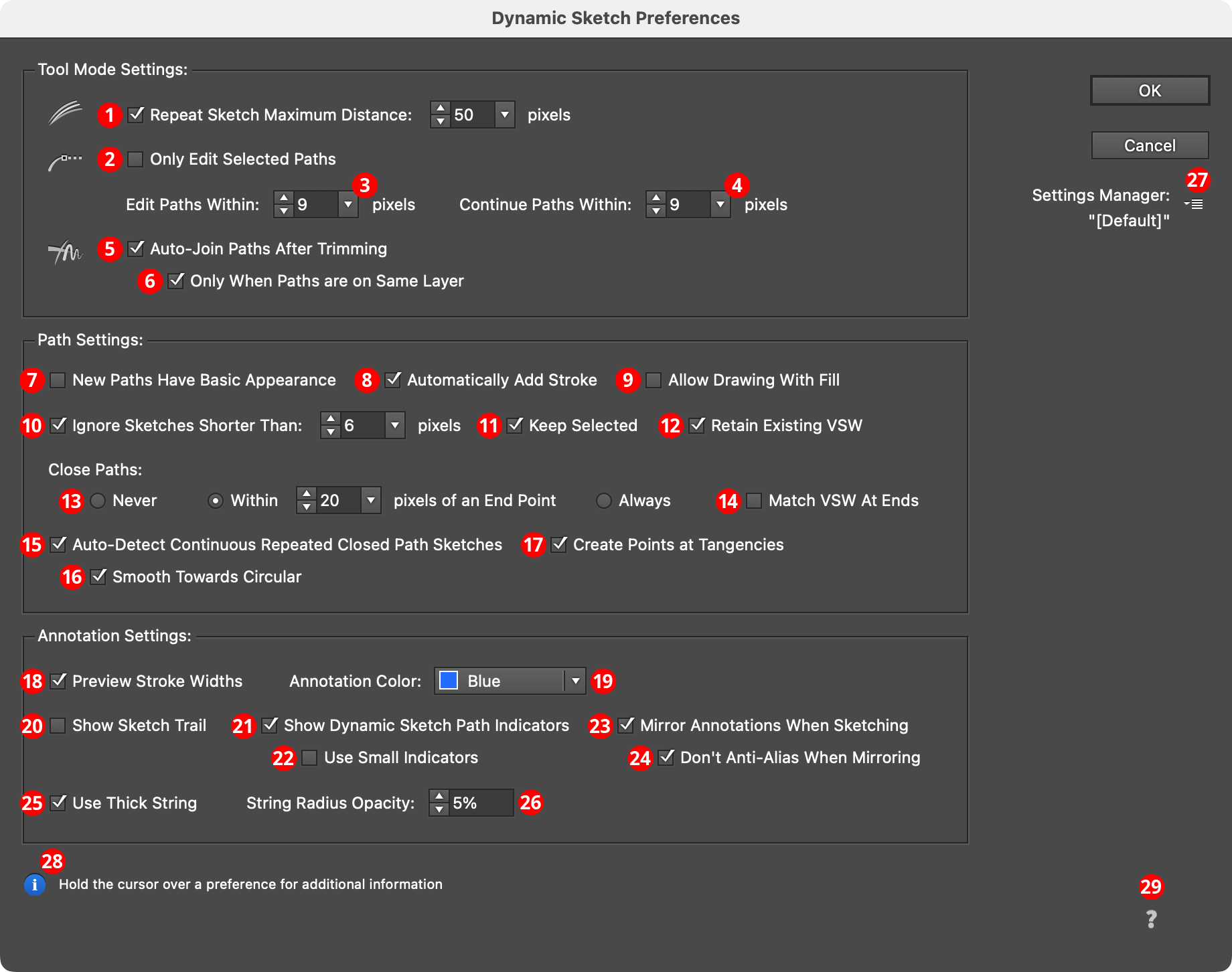
DynamicSketch Preferences
1. Repeat Sketch Traces Maximum Distance
When enabled, repeat sketch traces can only be added to an existing sketch path if the tool’s drag start is within the specified number of pixels of the original start of the path, making it quicker to start a new path some distance away.
2. Only Edit Selected Paths
When enabled, only paths which are already selected can be edited (or continued, or joined). This can make it easier to avoid accidentally editing a path.
3. Edit Paths Within
The maximum distance between the path and the cursor to allow editing of that path to take place. The default value is 9 pixels.
4. Continue Paths Within
The maximum distance between the path endpoint and the cursor to allow continuation of that path to take place. The default value is 9 pixels.
5. Auto-Join Paths After Trimming
Following a manual trim or gesture trim operation, paths with coincident endpoints will be detected and automatically joined, when possible.
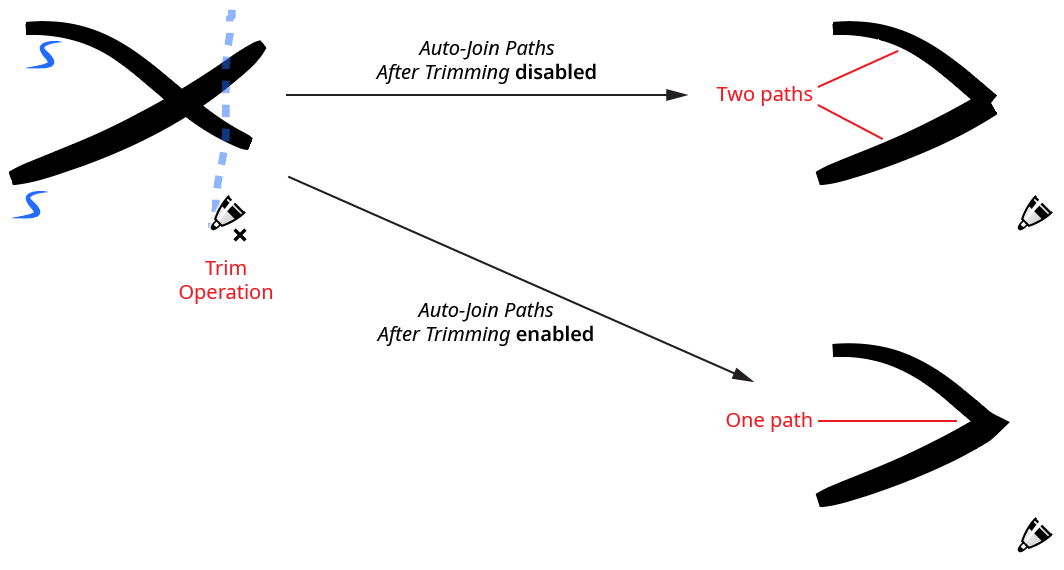
Dynamic Sketch Auto-Join Paths
When paths with variable stroke widths are joined, the width profiles of each section will be preserved as best as possible. Note that this is in contrast to joining the paths with the native Command/Ctrl-J, which instead takes the stroke width profile for the joined path from the topmost of the original paths.
6. Only When Paths Are On Same Layer
Available when Auto-Join Paths After Trimming is enabled, this preference ensures that joining will only occur if the trimmed paths are on the same layer.
7. New Paths Have Basic Appearance
Enabling this preference is the same as enabling the native preference New Art Has Basic Appearance (accessible through the flyout menu of the Appearance panel), except it only applied to the paths created with the Dynamic Sketch tool. To create paths with the current variable stroke width profile, enable both this preference and the Retain Existing VSW preference, and set the Width Input menu to None.
8. Automatically Add Stroke
When enabled, drawing a variable width sketch path when the current appearance has no stroke will automatically add a stroke (black in color) to ensure that the variable width data is retained. Otherwise the Width Input will automatically be set to None.
9. Allow Drawing With Fill
By default, Dynamic Sketch draws paths with a stroke only. If the current appearance includes a fill, then the following warning dialog is displayed:
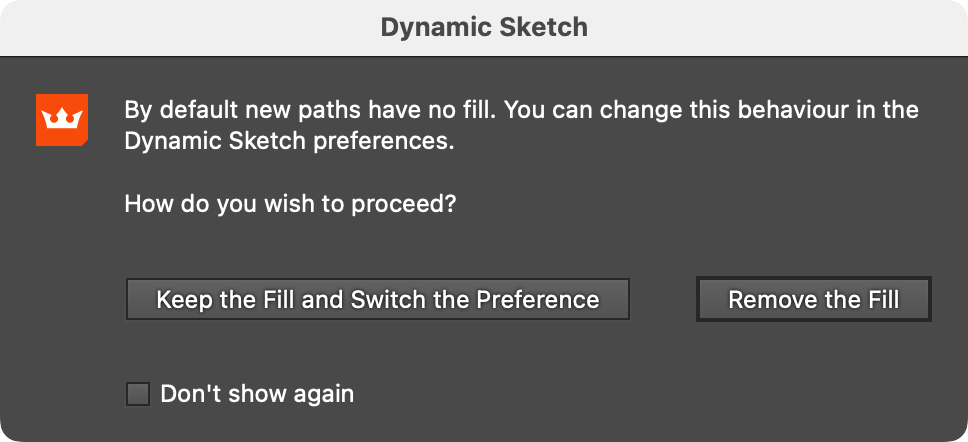
Dynamic Sketch No Fill Warning
Enabling this preference specifies that Dynamic Sketch should keep the fill (if any) when drawing new paths, and the warning dialog will never appear. To always remove the fill after drawing a sketch path without seeing the dialog, enable the “Don’t show again” checkbox and click the “Remove the Fill” button. Fills can still be manually added to any sketch path after it is drawn.
10. Ignore Sketches Shorter Than
When using a tablet, tapping the stylus to click often inadvertently drags the cursor a very short distance as well. To avoid very short sketch paths being created, enable this preference and specify a tolerance value; the default is 6 pixels.
11. Keep Selected
When enabled, drawing a new Dynamic Sketch path will not deselect the previously drawn path.
12. Retain Existing VSW
When enabled, drawing a sketch path with the Width Input menu set to None will retain the existing variable stroke width profile. The path, however, will not remain dynamic.
13. Close Paths
There are three options regarding closing paths when drawing a sketch path:
Never: Paths will never be closed, even if the ending point is very close to the starting point.
Within __ pixels of an endpoint: If the cursor ends within the specified distance of the starting point, the path will be closed. The cursor will show the “link” badge when this distance has been reached.
Always: The path will always be closed, using a straight segment between the ending and starting points.
14. Match VSW At Ends
When drawing a closed path with a variable stroke width, the widths will be adjusted so that the join point is smooth:
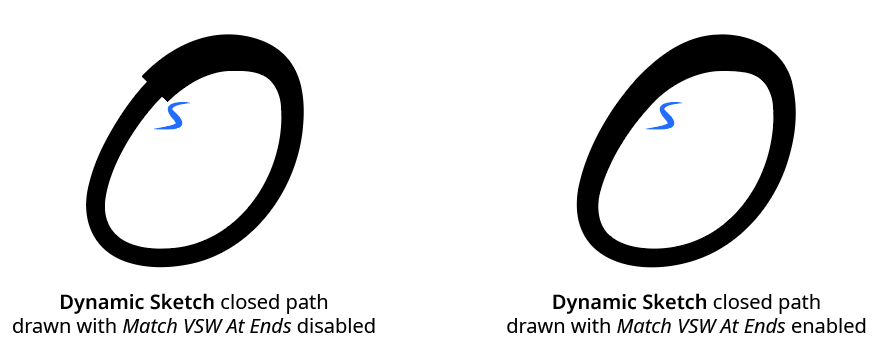
Dynamic Sketch Match Variable Stroke Width
15. Auto-Detect Continuous Repeated Closed Path Sketches
When enabled, closed sketch paths drawn so that they loop on top of themselves reasonably consistently (and at least twice) will be converted to a single, smooth closed path:
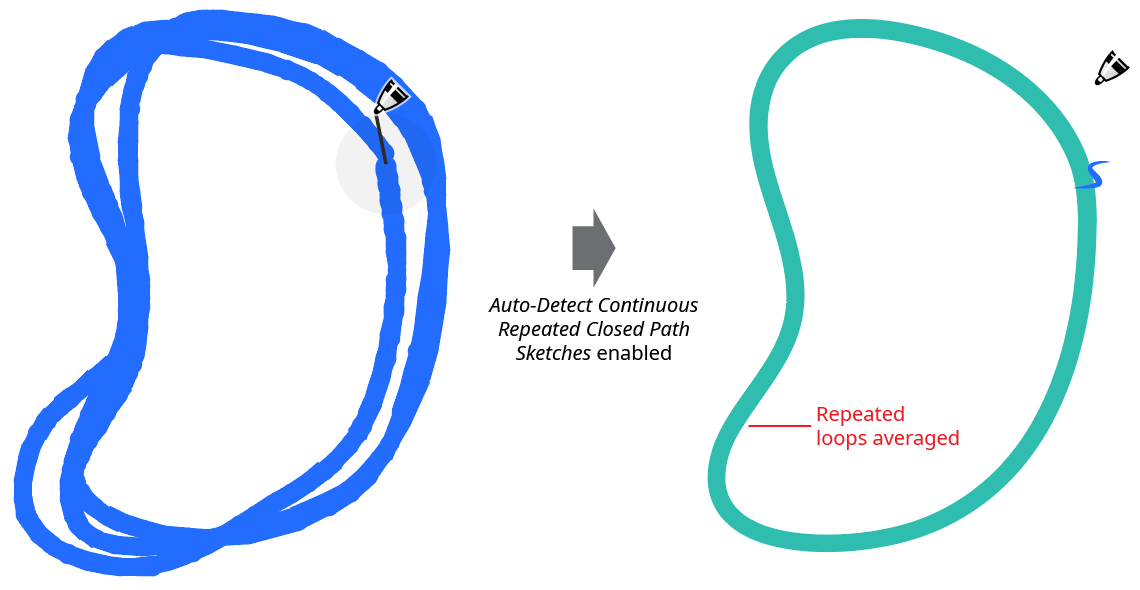
Dynamic Sketch Auto-Detect Continuous Repeated
16. Smooth Towards Circular
If Auto-Detect Continuous Repeated Closed Path Sketches is enabled, then enabling this preference allows the Smoothness setting to act as a blending parameter (in addition to its role in smoothing the stroke widths). In this case if the smoothness is set to 0%, the path will simply be an average of the repeated loops; the closer the smoothness is moved towards 100%, the closer the path will conform to a perfect circle.
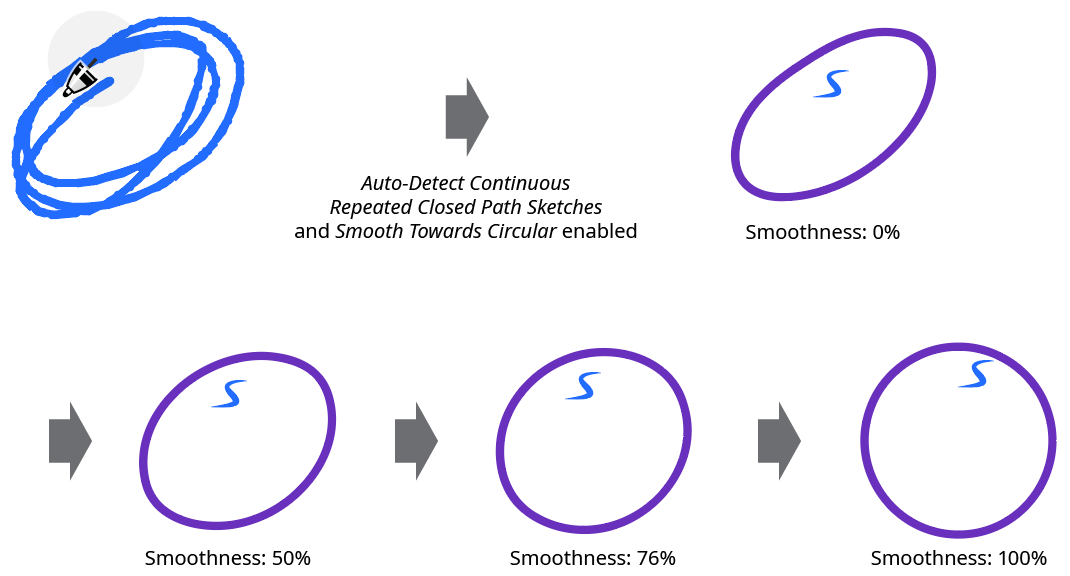
Dynamic Sketch Smooth Towards Circular
17. Create Points At Tangencies
When enabled, Dynamic Sketch will place the path’s anchor points, where possible, at positions on the path where the path is tangent to the vertical and horizontal axes (taking into account the current general constrain angle):
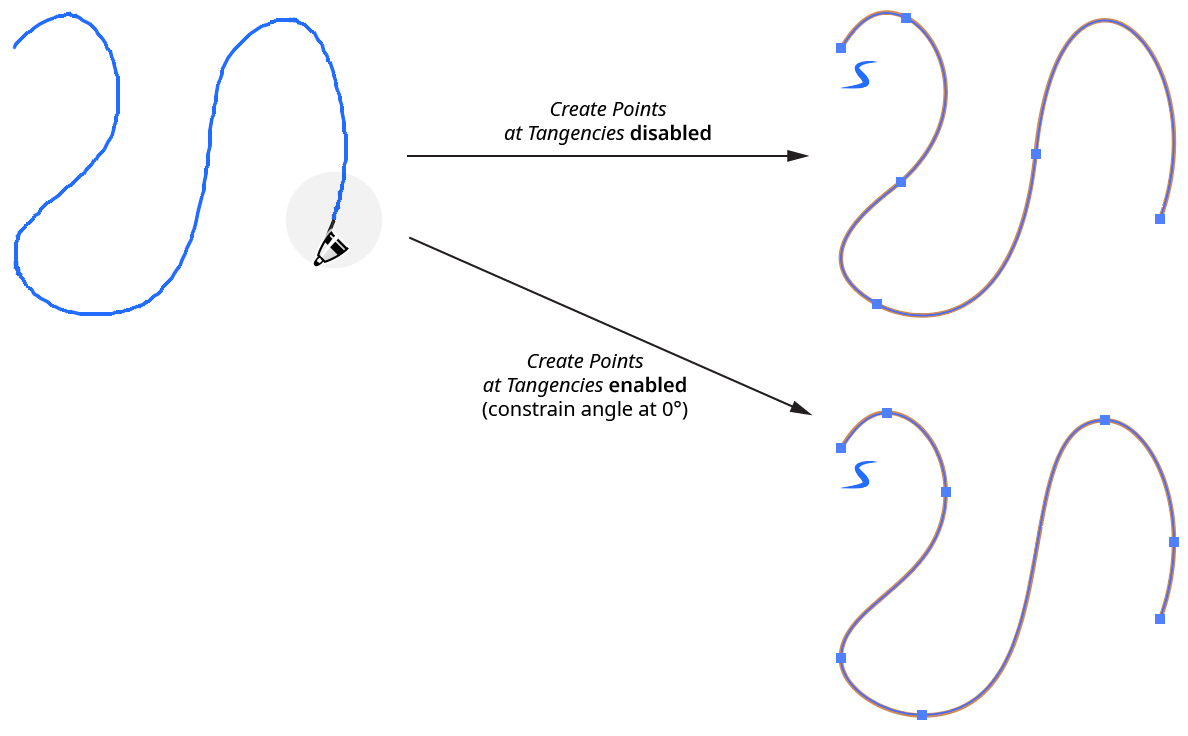
Dynamic Sketch Creates Points at Tangencies
18. Preview Stroke Widths
When enabled (the default), Dynamic Sketch will annotate an approximation of the width of the stroke while the sketch path is being drawn. When disabled, the path is only annotated with a 1-pixel wide line, like the native Pencil tool. This preference can be toggled on the fly (while dragging) with the S key.
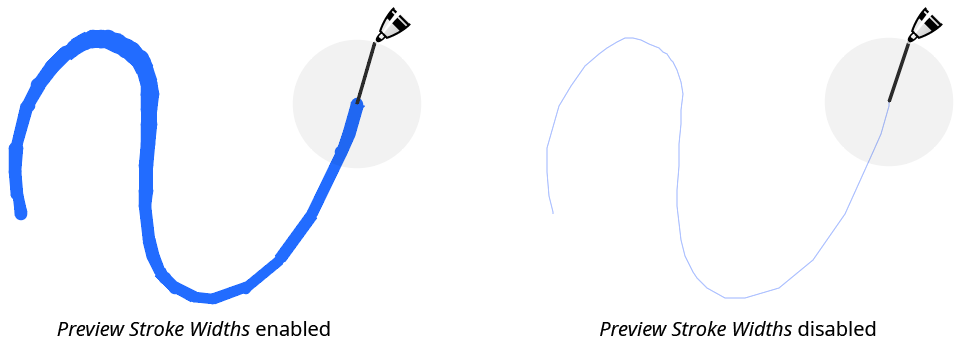
Dynamic Sketch Preview Stroke Width
19. Annotation Color
The menu allows a choice of annotation colors, from among blue (default), red, magenta, green, cyan, and black. This preference can be changed on the fly (while dragging) with the C key (each press of the key advances to the next color). If Preview Stroke Widths is disabled, or Show Sketch Trail is enabled, the sketch traces are always shown in light blue.
20. Show Sketch Trail
When enabled, the sketch traces (points laid down as the cursor was moved) are annotated in light blue even after the mouse button is released, thereby allowing a comparison of the resulting path with the original input trace(s).
21. Show Dynamic Sketch Path Indicators
When enabled, each active Dynamic Sketch path will be annotated with a small “swoosh” icon adjacent to its starting point (the default color is blue, but can be changed using the Annotation Color preference).
22. Use Small Indicators
The path indicators will be smaller in size that the default indicators.
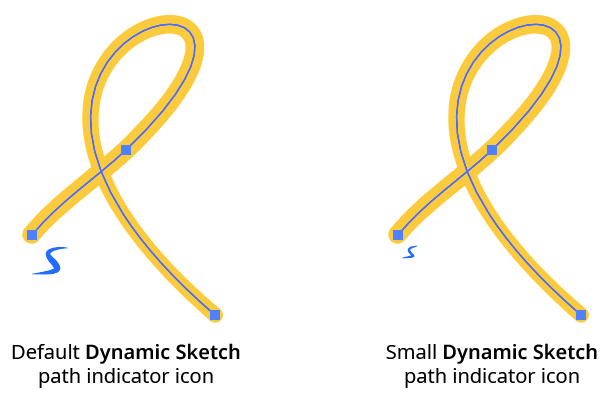
Dynamic Sketch Path Indicators
23. Mirror Annotations When Sketching
When using Astute Graphics’ MirrorMe plugin, and drawing into an active sector of mirroring axes applied to a layer, Dynamic Sketch can mirror its annotations during the sketching operation. This may result in slower performance. This preference can be toggled on the fly (while dragging) with the M key.
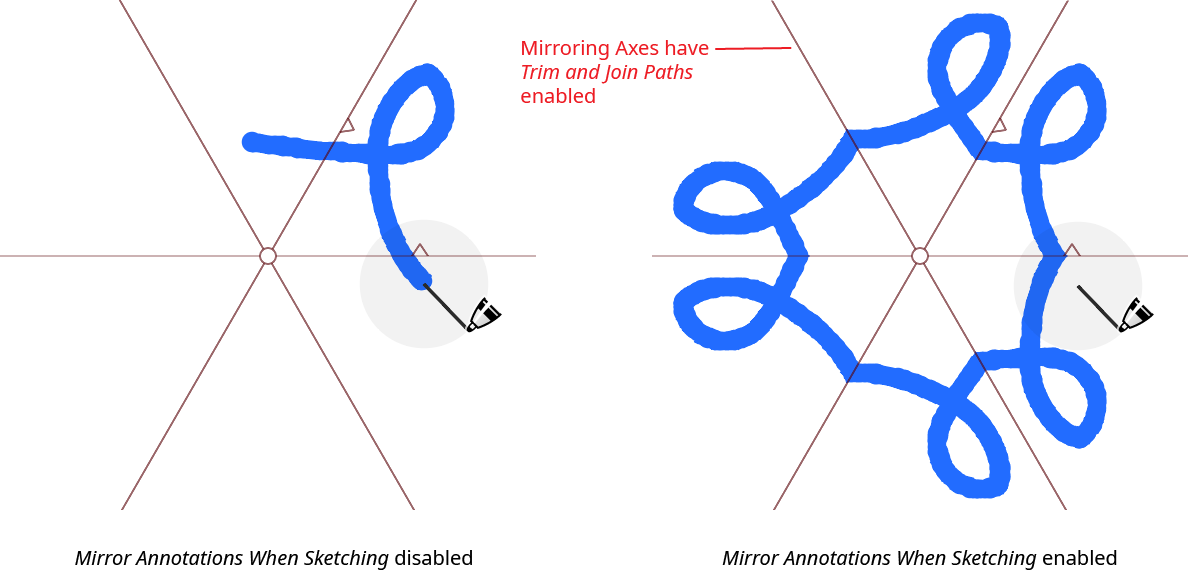
Dynamic Sketch Mirror Annotations
24. Don’t Anti-Alias When Mirroring
When using mirrored annotations, performance can be sped up somewhat by enabling this preference.
25. Use Thick String
When using the pulled cursor, annotates the string with a thicker line, which is easier to see on high-resolution monitors.
26. String Radius Opacity
When using the pulled cursor, controls the opacity of the “disc” which indicates the current length of the string (by its radius). The disc can be useful when making a sharp corner and the string has been made slack; when the cursor is subsequently moved, it indicates when the cursor will begin drawing again: when it reaches the edge of the disc. The default opacity is 5%.
27. Settings Manager
The Settings Manager popup menu provides access to saving, managing, and applying preference settings.
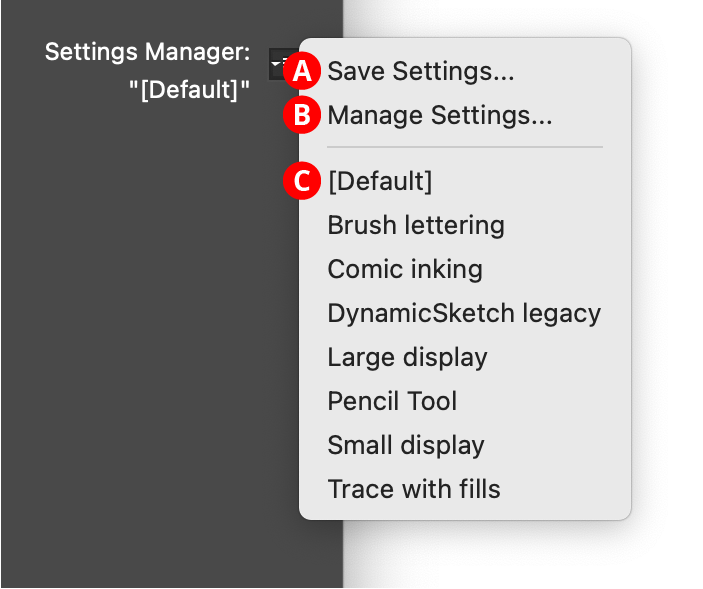
Dynamic Sketch Settings Manager
A. Save Settings...
When you save the preference settings, all of the current settings in the preferences dialog are captured in a file which can be recalled later. The file name may be specified.
B. Manage Settings...
Brings up the Manage Settings dialog, which lets you rename or delete existing settings files:
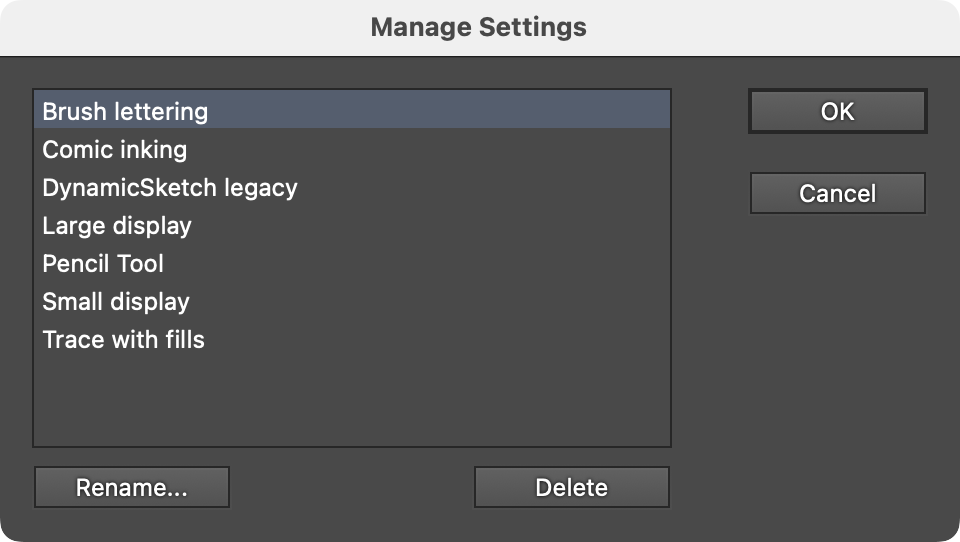
Dynamic Sketch Manage Settings Dialog
C. Settings List
Choosing a settings file from this list will change the preference settings to match the state of the dialog when the settings file was saved (or, the case of “[Default]”, to the default values).
28. Informational area
Shows a brief description of each preference control when the cursor is being hovered over it.
29. Help Button
Opens the help documentation in the Astute Manager. If this does not automatically appear, please ensure your Astute Manager is running first.
